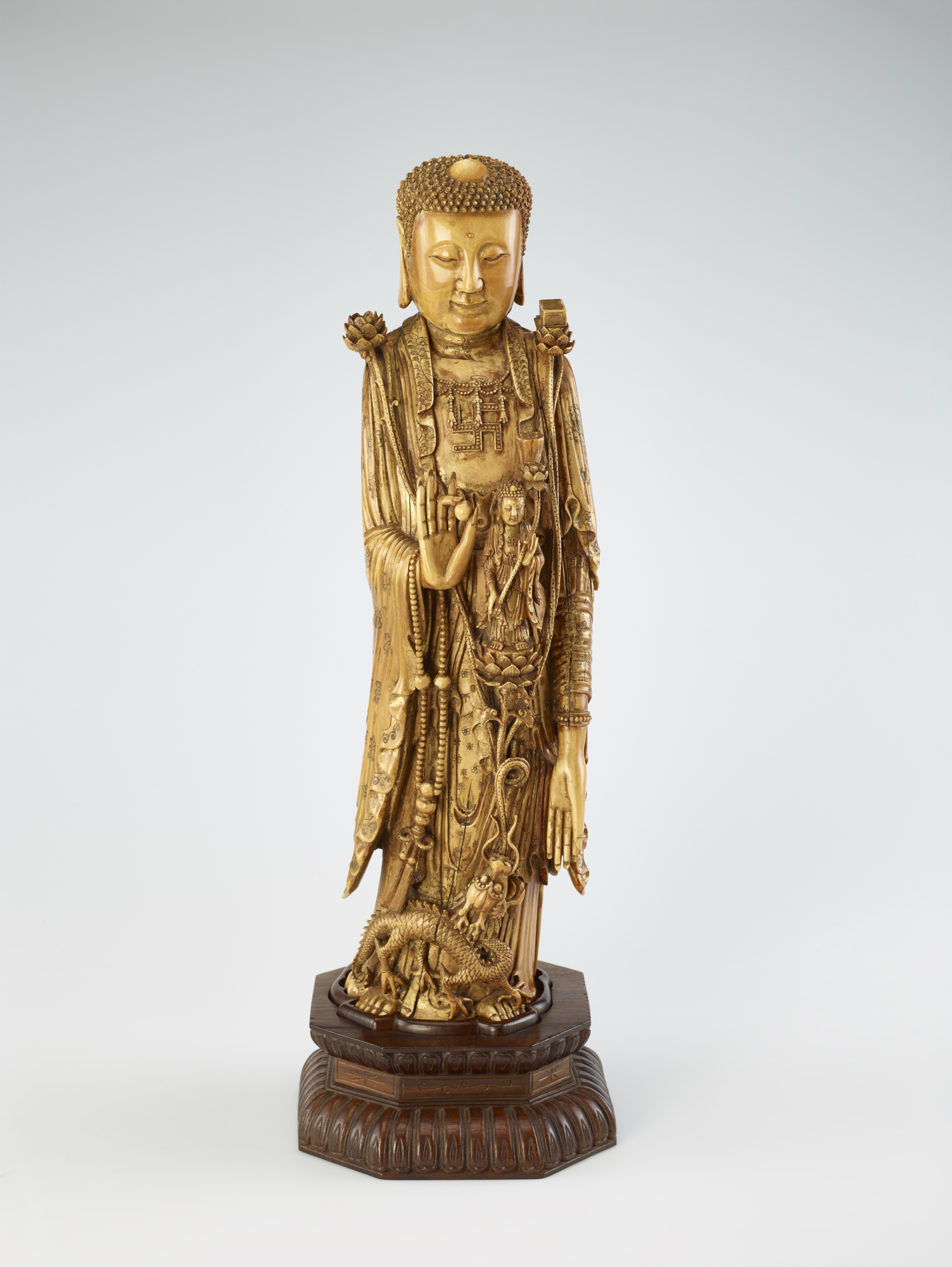Amitabha(ah-me-tah-bah) literally, “Infinite Light”; the Buddha of the Western Paradise. Widely revered in Mahayana Buddhist traditions, Amitabha enables his followers to be born into his paradise and attain Buddhahood in one lifetime.: literally, “Infinite Light”; the Buddha(bood-huh) literally, “Awakened One”; a being who has awakened to the true reality of existence and is thereby liberated from the cycle of birth, death, and rebirth. A Buddha teaches others the path to Enlightenment. of the Western Paradise. Widely revered in Mahayana(mah-huh-uah-nuh) a path of Buddhism that offers salvation to all and allows popular worship. Buddhist traditions, Amitabha enables his followers to be born into his paradise and attain Buddhahood in one lifetime.
bodhisattva(bo-dee-saht-vah) an enlightened being who chooses not to proceed to Nirvana but instead remains on earth to guide others in their paths toward enlightenment.: an enlightened being who chooses not to proceed to Nirvana(ner-vah-nuh) a spiritual state of perfect peace beyond selfish attachments to worldly possessions; reaching Nirvana frees one’s soul from the Buddhist cycle of birth, death, and rebirth. but instead remains on earth to guide others in their paths toward enlightenmenta moment of great wisdom and understanding; the highest level of consciousness, believed to be achieved through meditation and adhering to the basic moral teaching of Buddhism..
Buddha: literally, “Awakened One”; a being who has awakened to the true reality of existence and is thereby liberated from the cycle of birth, death, and rebirth. A Buddha teaches others the path to Enlightenment.
Dalai Lamathe spiritual leader of one of four major paths of Tibetan Buddhism.: the spiritual leader of one of four major sects of Tibetan Buddhism(bood-ihz-uhm) a widespread Asian religion or philosophy founded by Siddartha Gautama in northeastern India in the 5th century BCE..
Enlightenment: a moment of great wisdom and understanding; the highest level of consciousness believed to be achieved through meditation and adhering to the basic moral teachings of Buddhism.
Guanyin(gwahn-yin) also known as Guan-shi-yin; in Sanskrit, Avalokiteshvara, literally “The Lord who Looks Down [from on High]”; the widely worshipped bodhisattva of compassion who protects and saves all beings.: also known as Guan-shi-yin; in Sanskrit, Avalokiteshvara(ah-vuh-low-kee-taysh-vuh-ra) literally, “The Lord who Looks Down [from on High]”; the widely worshipped bodhisattva of compassion who protects and saves all beings., literally “The Lord who Looks Down [from on High]”; the widely worshipped bodhisattva of compassion who protects and saves all beings.
Guan-shi-yin Sutra(gwahn shir yin soo-truh) twenty-fifth chapter of the Lotus Sutra that is devoted to the bodhisattva Guanyin and details his ability to rescue the faithful from various dangers.: twenty-fifth chapter of the Lotus Sutraone of the most influential texts of Mahayana Buddhism, the form of Buddhism predominant in East Asia. It contains the words and teachings of Shakyamuni, the Historical Buddha. that is devoted to the bodhisattva Guanyin and details his ability to rescue the faithful from various dangers.
Lotus Sutra(soo-truh) a Buddhist holy writing or text.: one of the most influential texts of Mahayana Buddhism, the form of Buddhism predominant in East Asia. It contains the words and teachings of Shakyamuni(Shah-kya-moo-knee) literally, “Sage of the Shakya Clan”; the Historical Buddha. His given name was Siddhartha (sid-har-ta) Gautama. He lived in northeastern India sometime after the fifth century BCE., the Historical Buddha.
Nirvana: a spiritual state of perfect peace beyond selfish attachments to worldly possessions; reaching Nirvana frees one’s soul from the Buddhist cycle of birth, death, and rebirth.
reincarnationrebirth in a new body or form of life.: rebirth in a new body or form of life.
Siddhartha Gautama(sihd-dahr-tuh gaw-tuh-muh) the given name of Shakyamuni, literally “Sage of the Shakya Clan,” the Historical Buddha. He lived in northeastern India sometime after the fifth century BCE.: the given name of the Shakyamuni, literally “Sage of the Shakya Clan,” the Historical Buddha. He lived in northeastern India sometime after the fifth century BCE.
urna(oor-nah) a dot on the Buddha’s forehead that indicates his special wisdom.: a dot on the Buddha’s forehead that indicates his special wisdom.
usnisa(oosh-neesh-ah) a bump on the top of the Buddha’s head that symbolizes his superior knowledge.: a bump on the top of the Buddha’s head that symbolizes his superior knowledge.






